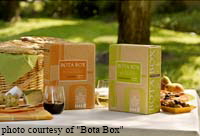Home | ARTICLES | Food_Trivia | Today_In_Food_History | Food_History_Timeline | Recipes | Cooking_Tips | Food_Videos | Food_Quotes | Who's_Who | Cooking Schools_&_Tours | Food_Trivia_Quizzes | Food_Poems | Free_Magazines | Food_Festivals_&_Events

You are here > Home > Food Articles >
CULINARY SCHOOLS &
COOKING CLASSES
From Amateur & Basic Cooking Classes to Professional Chef Training
Over 1,000 schools & classes listed for U.S., Online & Worldwide
FREE Food & Beverage Publications
An extensive selection of free magazines and other publications for qualified Food, Beverage & Hospitality professionals
Boxed Wine Saves Resources And Energy
Dear EarthTalk: Apparently boxed wine (instead of bottled) is becoming all the rage for environmental reasons. What are the eco-benefits of boxed wine over bottled?
-- Justin J., Los Angeles, CA
With more and more wineries offering organic varieties to lower their eco-footprint, it’s no surprise that they’re looking at the environmental impacts of their packaging as well. The making of conventional glass bottles (and the corks that cap them) uses significant quantities of natural resources and generates considerable pollution. According to the U.S. Environmental Protection Agency, the process of manufacturing glass not only contributes its share of greenhouse gas emissions but also generates nitrogen oxides, sulfur dioxide and tiny particulates that can damage lung tissue when breathed in.
 Beyond manufacturing, the transport of wine in glass bottles across the country and around the world also takes its environmental toll. According to wine writer Tyler Colman, upwards of 90 percent of American wine is produced on the West Coast, but then shipped to the East Coast where the majority of wine consumers live. Trucking all these heavy glass bottles generates a much larger carbon footprint, ounce-for-ounce than the transportation of much lighter boxed wine. Almost half the weight of an ordinary case of wine comes from the bottles; about 95 percent of the weight of a case of boxed wine is the wine itself.
Beyond manufacturing, the transport of wine in glass bottles across the country and around the world also takes its environmental toll. According to wine writer Tyler Colman, upwards of 90 percent of American wine is produced on the West Coast, but then shipped to the East Coast where the majority of wine consumers live. Trucking all these heavy glass bottles generates a much larger carbon footprint, ounce-for-ounce than the transportation of much lighter boxed wine. Almost half the weight of an ordinary case of wine comes from the bottles; about 95 percent of the weight of a case of boxed wine is the wine itself.
 “A standard wine bottle holds 750 milliliters of wine and generates about 5.2 pounds of carbon-dioxide emissions when it travels from a vineyard in California to a store in New York,” reports Colman, who blogs at DrVino.com. “A 3-liter box generates about half the emissions per 750 milliliters.” He concludes that switching to wine in a box “for the 97 percent of wines that are made to be consumed within a year” would reduce greenhouse gas emissions by about two million tons, or the equivalent of removing 400,000 cars from the roads.
“A standard wine bottle holds 750 milliliters of wine and generates about 5.2 pounds of carbon-dioxide emissions when it travels from a vineyard in California to a store in New York,” reports Colman, who blogs at DrVino.com. “A 3-liter box generates about half the emissions per 750 milliliters.” He concludes that switching to wine in a box “for the 97 percent of wines that are made to be consumed within a year” would reduce greenhouse gas emissions by about two million tons, or the equivalent of removing 400,000 cars from the roads.
According to the Wine Group, the third largest wine company in the world by volume and a big advocate for switching away from glass bottles, there are other advantages to boxed wine (which typically includes a plastic bag within a cardboard box). The vacuum packaging of boxed wines allows the contents to stay fresh for up to six weeks in the fridge once the seal is broken and the first glass has been poured. The Wine Group has launched the “Better Wines Better World” website in an attempt to curry public favor for technologically advanced, environmentally friendly and economically practical boxed wines.
Still, despite the benefits, boxed wine may still be a tough pill to swallow for many wine connoisseurs still bent on tradition. “Even those traditionalists who are coming around to the idea that maybe screw caps are fine for some wines, balk at the idea of a cellar full of cardboard boxes,” says wine writer and vineyard owner Lee Asbell. “It is difficult to imagine how wine service at fine-dining establishments would handle such a change.” For now, boxed wine is still the domain of cheaper brands. But that could all change as more and more wine makers and drinkers take up the mantle of saving the Earth.
CONTACTS: Better Wines Better World, www.betterwinesbetterworld.com
DrVino, www.drvino.com
SEND YOUR ENVIRONMENTAL QUESTIONS TO: EarthTalk®, P.O. Box 5098, Westport, CT 06881; earthtalk@emagazine.com . Read past columns at: www.emagazine.com/earthtalk/archives.php.
RELATED ARTICLES
Please feel free to link to any pages of FoodReference.com from your website.
For permission to use any of this content please E-mail: james@foodreference.com
All contents are copyright © 1990 - 2024 James T. Ehler and www.FoodReference.com unless otherwise noted.
All rights reserved.
You may copy and use portions of this website for non-commercial, personal use only.
Any other use of these materials without prior written authorization is not very nice and violates the copyright.
Please take the time to request permission.
